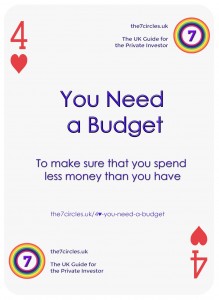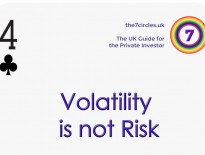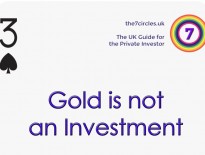4♥ – You Need A Budget
You need a budget to make sure that you spend less money than you have.
This post is part of the MoneyDeck series, a pack of 52 playing cards that describe 52 “golden rules” for Private Investors in the UK.
Annual income twenty pounds, annual expenditure nineteen six, result happiness. Annual income twenty pounds, annual expenditure twenty pounds six, result misery. – Charles Dickens
These days, you probably need to save more than sixpence a year, but the principle remains true.
You need a budget – to make sure that you spend less money than you have.
Having a budget ((Two kinds of budget you can ignore for today are the Chancellor’s annual financial statement, and the remarkably popular software package called You Need A Budget – save your money and use pen and paper, or the free Google Sheets )) is all about being in control. You need to know what is supposed to happen with all your money, and just as importantly, what is actually happening.
This is a challenge for everyone, not just those on low incomes. Lifestyle creep and keeping up with the Joneses mean that many people with good jobs and high incomes struggle to make ends meet each month.
People with variable incomes, such as the self-employed, have a particular problem.
Not balancing the books means, stress and worry, tense relationships, and an inability to look forward to a better future.
A budget system can fix that.
A budget is just a spending plan that balances your income and your expenditure. It tells you where your money is going, and helps you work towards your future financial goals.
As with all planning and control systems, budgeting is all about getting the better of your irrational lizard brain – the ancient brain stem that controls flight or fight, and greed.
It’s a simple concept, but it’s fundamental to building wealth and moving towards financial independence. You must consistently spend less than you earn over some time period (a month, a year).
If you can’t achieve this, everything else is futile. You have to live within your means.
And if you aren’t already spending less than you earn, a budget can help.
The most popular approach to budgeting is the envelope system.
Originally – back in the days when people were paid weekly and in cash – this really was a set of envelopes tied together by a rubber band.
These days people are paid electronically once a month, and they use software. ((Often – especially in the US – they use the YNAB package I mentioned above; you don’t need it – a free spreadsheet will work just as well ))
The envelope system requires you to allocate all of your income to a separate purpose. In the YNAB jargon this is known as “giving every pound a job”.
The point of this is to stop you thinking of all your money as one big lump that can be spent on everything. That approach makes it too difficult for your lizard brain to understand whether you can afford to buy something.
You have to stop making the purchase decision based on whether you have a positive balance in your current account.
So you have a separate budget for your mortgage, your household bills (phone, TV, broadband, heat, light), your food, your entertainment.
How far down this rabbit hole you need to go depends on your personality, and on how out of control your spending is. Some people will only need five buckets, others twenty-five.
If you can, add a bucket for savings. If that’s too much of a stretch at the start, you can add it later.
Remember to make the total of all the buckets – including savings if possible – add up to your income for the month.
Step two is to track your spending. At the beginning, this needs to be accurate down to the penny.
Once you are regularly spending less than you earn, and saving as much as you expect, you can relax and move on to other goals.
But at the start, when things are not the way you’d like, you need to understand exactly why.
If you end up spending money on something you didn’t anticipate, just create a new bucket. The point at the start is not to stick exactly to you plan, but to understand what needs to change.
At the end of the month, compare your spending in each bucket with your plan. Some of the buckets will have money left in them, others will be over-spent.
If you’re a typical commuter, lunch and coffee and snacks and takeaway food will probably add up to more than you expected.
Don’t worry if you’ve overspent on a few things, or even if you’ve overspent your entire budget. This is just the first battle, not the end of the war.
Feeling like a failure at this point will only give your lizard brain the upper hand, and make it more likely that you quit.
There’s always next month.
So now you need to set up a new budget for the next month.
The target for next month is simply to do better than last month. Always compare yourself to a version of you from the past. Never look at what anyone else is doing.
In each bucket, you need to carry forward the balance from the previous month – either the cash you have left, or the negative balance that you overspent.
Don’t use the cash left over in a “good” bucket to reward yourself with a treat – it belongs to next month now.
You also need to decide whether you will spend as much as you did last month or you can make savings.
Maybe you can get all the way back to your original target for month one. Or maybe your target for month two will be somewhere between month one target and month one spending.
It’s up to you. As long as the total plan for month two is less than your income for month two, you can allocate it how you like.
You get the picture – each month you track your spending and adjust your plan for the next month.
After a few months you should be spending according to plan.
If you aren’t, then it’s likely that you’re going to need some outside help to get on top of things. The Money Advice Service or Citizens Advice might be good places to start.
One thing to consider is how to deal with things that don’t come up every month. Like holidays or quarterly bills, or an expensive new gadget – or Christmas.
I think the best approach is to divide the spend by the number of months and save a little towards it each month.
So the balance in the bucket will build up to the correct total by the time that it’s needed. This is a version of the old motto “save for a rainy day”.
Don’t worry if you can’t think of all the big stuff in month one. It will come up as you work your way through the first year. or you could go back through your bank and credit card statements for the previous year.
At the end of the first year, add up what you’ve spent in each category. Is it what you expected? Is there anywhere you could cut back?
This should help you to set targets for the next year.
Now all this sounds like a lot of work, and it is at first.
Once you’re a few months in, you just have to reconcile your bank statement and your credit card statement to your budget. One tip is to use a debit card rather than cash wherever you can – contactless makes this easy nowadays.
That reconciliation might take an hour each month.
If you are currently spending more than you earn, or so much that you can’t save for the future, it will be the most worthwhile hour that you could spend.
Once you’re hitting you targets, you can stop tracking in detail until you hit a problem.
So remember, you need a budget – to make sure that you spend less money than you have.
Until next time.

